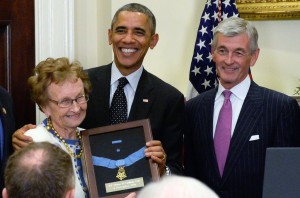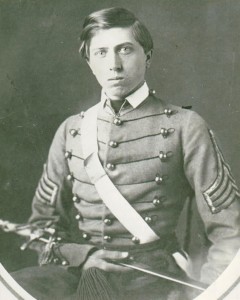Alonzo Hereford Cushing was born on Jan. 19, 1841, in Delafield, Wisconsin, and was raised in Fredonia, New York. Cushing was appointed to the United States Military Academy at West Point, New York, in 1857. Upon graduation in June 1861, he was commissioned a first lieutenant in the U.S. Army.
Cushing participated in most of the campaigns and battles of the Army of the Potomac, to include Bull Run (Virginia), Antietam (Maryland), Fredericksburg (Virginia), Chancellorsville (Virginia), and Gettysburg (Pennsylvania). Cushing also trained volunteer troops in Washington, D.C., served as an ordnance officer on the staff of Gen. Edwin V. Sumner, and as a topographical engineer. During the Chancellorsville Campaign, Cushing was promoted to command Battery A, 4th United States Artillery, in the Army of the Potomac’s II Corps.
Cushing was killed in action on July 3, 1863, at the age of 22. Although he received a posthumous brevet promotion to lieutenant colonel for his service at the Battle of Gettysburg, on July 1, 1863, no award was awarded to Cushing for his efforts during that critical day of battle. He was buried with full honors at his alma mater, West Point, beneath a headstone inscribed, “Faithful unto death.”
OFFICIAL CITATION
The President of the United States of America, authorized by Act of Congress, March 3, 1863, has awarded in the name of Congress the Medal of Honor to
FIRST LIEUTENANT ALONZO H. CUSHING
UNITED STATES ARMY
For conspicuous gallantry and intrepidity at the risk of his life above and beyond the call of duty:
First Lieutenant Alonzo H. Cushing distinguished himself by acts of bravery above and beyond the call of duty while serving as an Artillery Commander in Battery A, 4th U.S. Artillery, Army of the Potomac at Gettysburg, Pennsylvania on July 3, 1863 during the American Civil War. That morning, Confederate Forces led by General Robert E. Lee began cannonading First Lieutenant Cushing’s position on Cemetery Ridge. Using field glasses, First Lieutenant Cushing directed fire for his own artillery battery. He refused to leave the battlefield after being struck in the shoulder by a shell fragment. As he continued to direct fire, he was struck again, this time suffering grievous damage to his abdomen. Still refusing to abandon his command, he boldly stood tall in the face of Major General George E. Pickett’s charge and continued to direct devastating fire into oncoming forces. As the Confederate Forces closed in, First Lieutenant Cushing was struck in the mouth by an enemy bullet and fell dead beside his gun. His gallant stand and fearless leadership inflicted severe casualties upon Confederate Forces and opened wide gaps in their lines, directly impacting the Union Forces’ ability to repel Pickett’s Charge. First Lieutenant Cushing’s extraordinary heroism and selflessness above and beyond the call of duty, at the cost of his own life, are in keeping with the highest traditions of military service and reflect great credit upon himself, Battery A, 4th U.S. Artillery, Army of the Potomac, and the United States Army.
Watch the Minnesota Civil War Commemoration Task Force video on 1st Lt. Cushing at Gettysburg here.
President awards MoH to Cushing’s cousin
WASHINGTON (Army News Service, Nov. 6, 2014) — President Barack Obama awarded the Medal of Honor to 1st Lt. Alonzo H. Cushing for helping stop Maj. Gen. George E. Pickett’s Charge at Gettysburg on July 3, 1863.

President Barack Obama awards the Medal of Honor to 1st Lt. Alonzo H. Cushing for his gallantry during combat at Gettysburg July 3, 1863. Receiving the medal at the White House ceremony, Nov. 6, 2014, is Helen Loring Ensign, Cushing’s first cousin, twice removed. Some 24 other descendants were present as well. To the president’s immediate right is Secretary of the Army John M. McHugh. Photo Credit: Staff Sgt. Laura Buchta
The ceremony took place in the Roosevelt Room of the White House, today. Helen Loring Ensign accepted the medal on behalf of Cushing, her first cousin, twice removed. Some 24 other descendants were present as well.
Long before Gettysburg, the West Point graduate “fought bravely” at the battles of Bull Run, Antietam, Chancellorsville and Fredericksburg, developing a reputation for “his cool, his competence and his courage under fire,” Obama said.
Cushing commanded Battery A, 4th U.S. Artillery, 2nd Corps, Army of the Potomac, atop Cemetery Ridge. On that fateful day, some 10,000 of Gen. Robert E. Lee’s troops advanced toward them in a line, elbow-to-elbow, a mile wide, in the final, desperate hours of the battle.
Smoke from the guns obscured the battlefield and the air was thick with lead. In the chaos, Cushing was hit and badly wounded, the president continued. His first sergeant, Frederick Fuger, urged him to fall back to the safety of the rear, away from the punishing fire. But Cushing refused, telling Fuger he’d rather “fight it out or die in the attempt.”
Bleeding badly and growing weaker every moment, he moved his remaining artillery closer to the front and continued to defend the Union line. “He used his own thumb to stop his gun’s vent, burning his finger to the bone,” the president related.
When Cushing was hit the final time, the 22-year-old Soldier fell beside his gun. Obama said Cushing was later immortalized by a poet, who wrote: “His gun spoke out for him once more before he fell to the ground.”
In a letter to Cushing’s sister, Fuger wrote that “the bravery of their men that day was entirely due to your brother’s training and example set on numerous battlefields.” Etched on Cushing’s tombstone at West Point is the simple epitaph, “Faithful unto death,” the president said. And, his memory will be honored later this month, when a Navy cruiser — the USS Gettysburg — dedicates its officer’s dining hall as the “Cushing Wardroom.”
Unbeknownst to Cushing, Gettysburg was a turning point in the war, the president said, and it was men like Cushing who were responsible for the victory. Historians often refer to the where Pickett’s Charge was stopped as the “high water mark of the Confederacy.”
When President Lincoln later dedicated the Soldiers’ National Cemetery in Gettysburg, he said these men gave their “last full measure of devotion.”
Cushing’s story “is part of our larger American story — one that continues today,” the president concluded. “The spirit, the courage, the determination that he demonstrated lives on in our brave men and women in uniform who this very day are serving and making sure that they are defending the freedoms that Alonzo helped to preserve.
“And, it’s incumbent on all of us as Americans to uphold the values that they fight for, and to continue to honor their service long after they leave the battlefield — for decades, even centuries to come.”
MEDAL LONG IN COMING

A Soldier displays the Medal of Honor for 1st Lt. Alonzo H. Cushing, awarded during a White House ceremony, Nov. 6, 2014, to recognize Cushing’s heroism at the Battle of Gettysburg. Photo Credit: Staff Sgt. Laura Buchta
Margaret Zerwekh, 94, a historian, attended the White House ceremony and was recognized by the president. Zerwekh did research on Cushing’s service in the Civil War. She was certain his valorous actions merited the Medal of Honor and lobbied her congressmen for decades to make it happen. She became interested in Cushing’s story, since she lives on property in Wisconsin that was once owned by his father.
Typically, the medal is awarded within a few years of the action. Obama said, “but sometimes, even the most extraordinary stories can get lost in the passage of time. No matter how long it takes, it is never too late to do the right thing.”
This medal is about more than just one Soldier, Obama said. “It reflects our obligations as a country to the men and women in our armed services; obligations that continue long after they return home, after they remove their uniforms and even, perhaps especially, after they’ve laid down their lives.”


